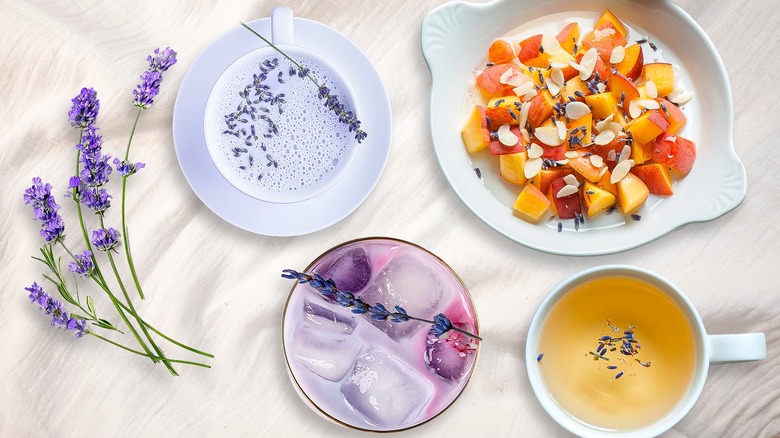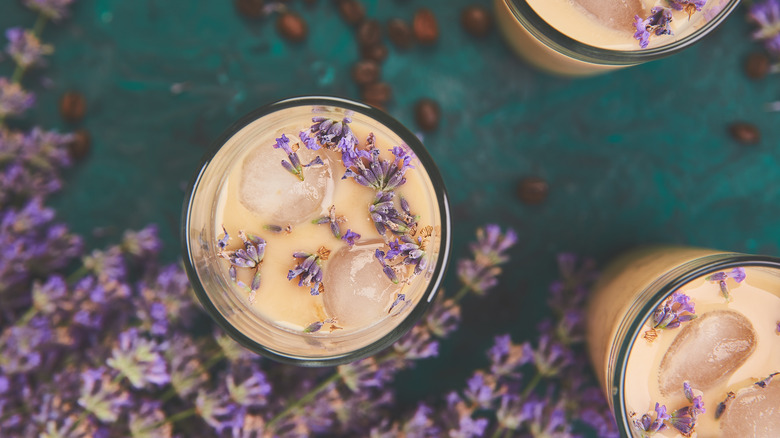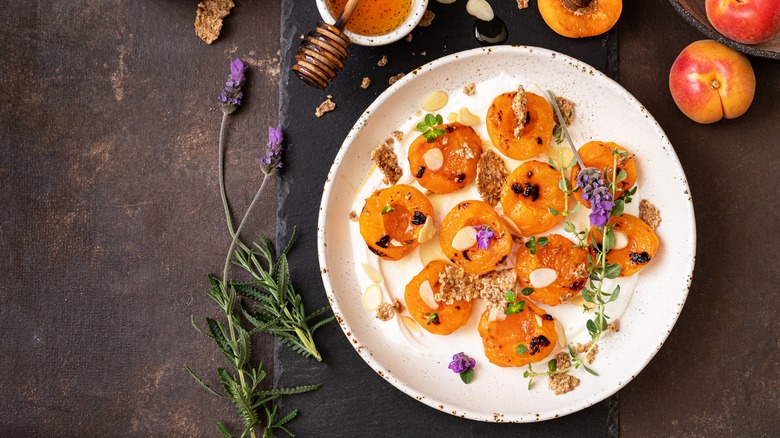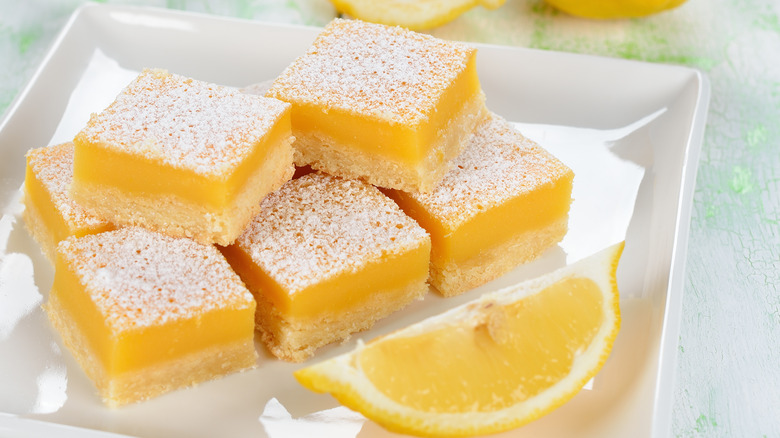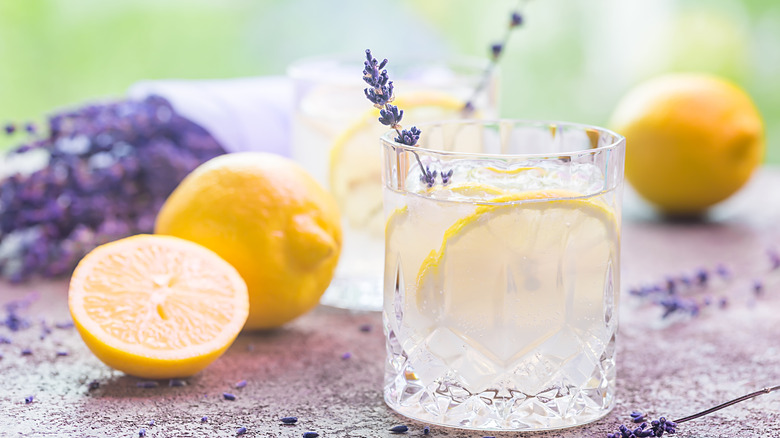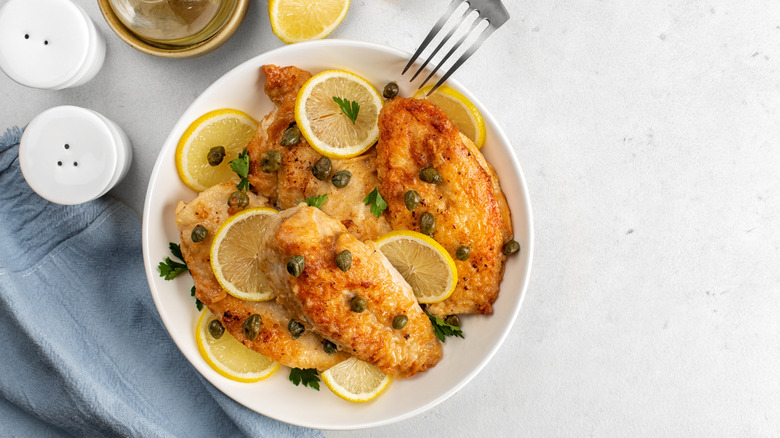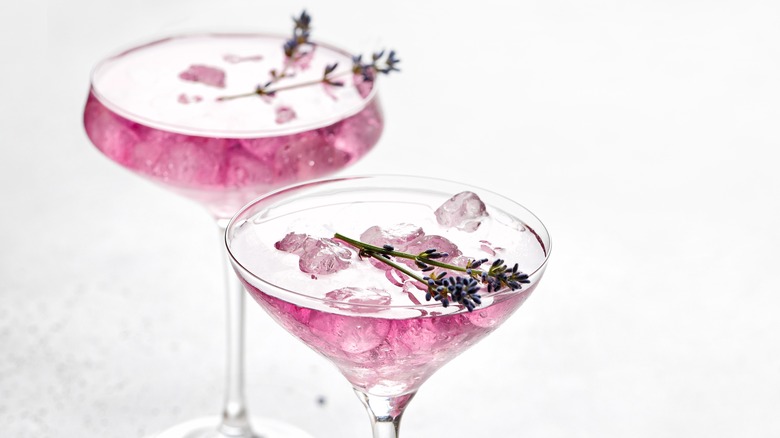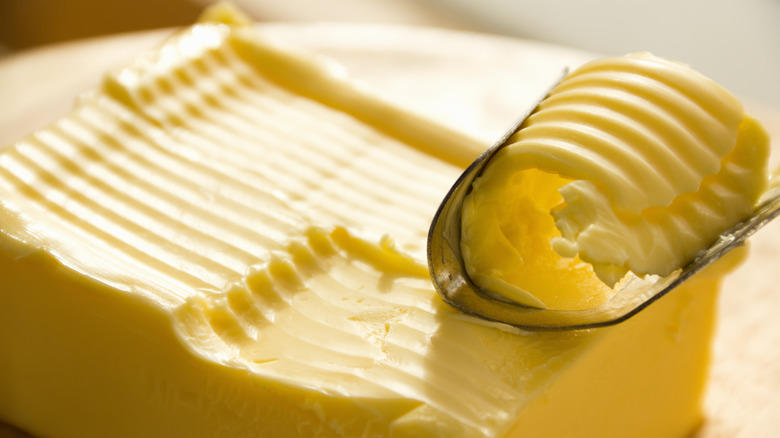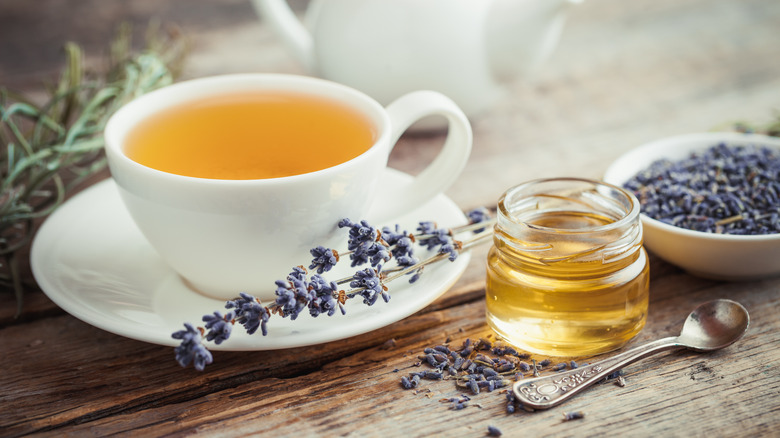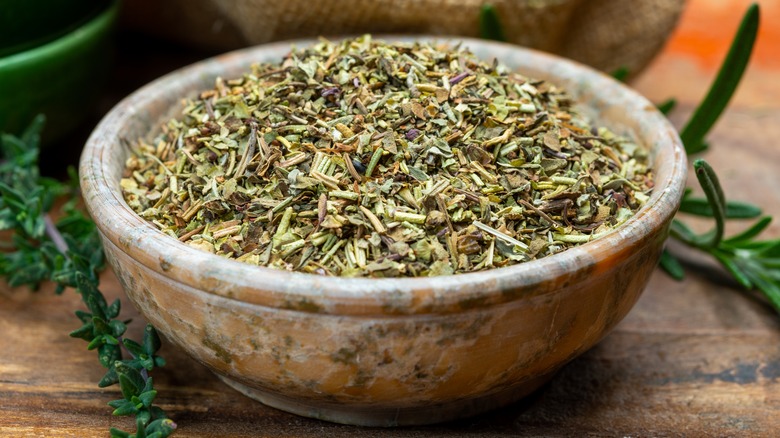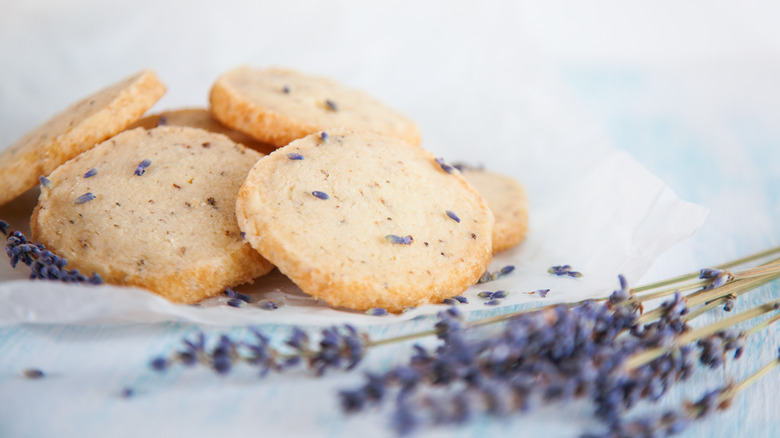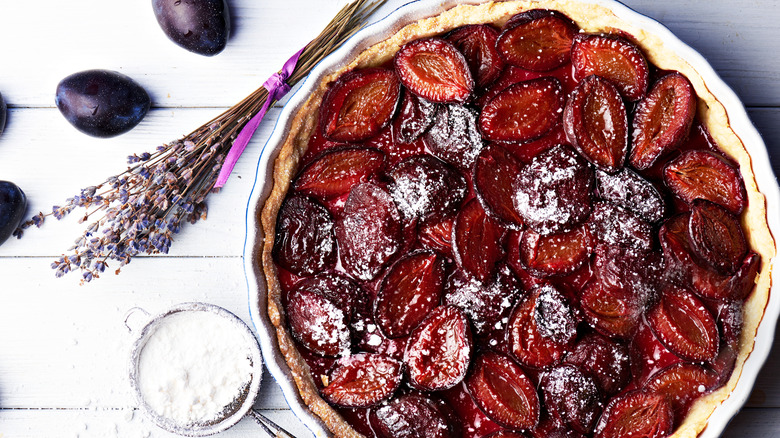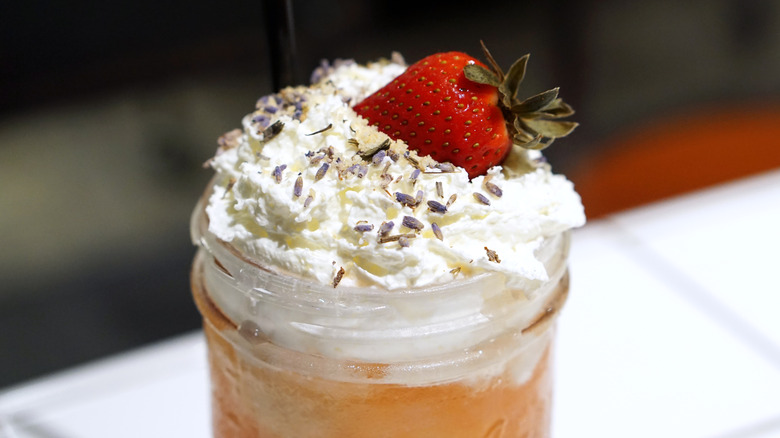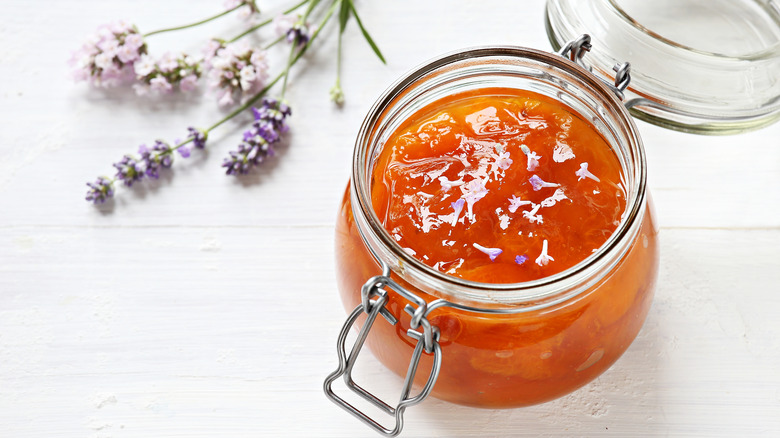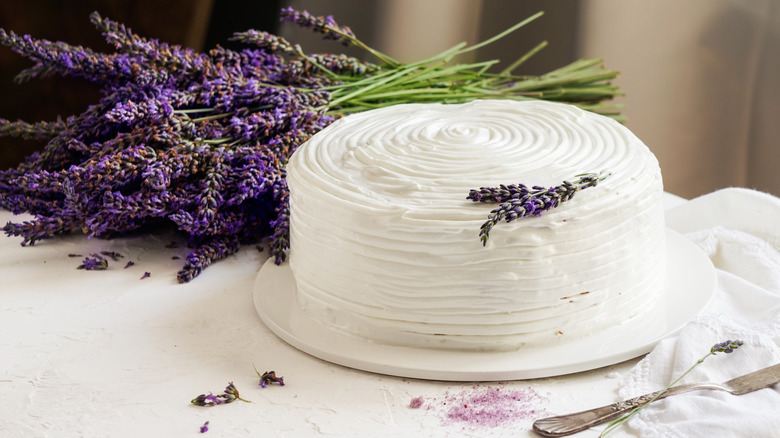15 Creative Ways To Use Lavender In Your Cooking
Lavender's charming purple flowers and alluring scent make it a favorite for beauty and body care, but did you know it's an edible flower that you can use in your cooking, too? Lavender provides a floral, woody, earthy profile to foods and beverages, which ranges based on which part of the plant you use (the flowers tend to be floral whereas the leaves and stems are herby). It has some notes of mint and rosemary, too, since it's part of the lamiaceae family. When cooking with this lovely plant, lavender simple syrup is a good jumping-off point since you can make one batch with dried or fresh flowers and then drizzle it into various beverages and food.
It's worth noting that you must use culinary lavender, not just something that you found on the side of the road, as this variety has a more palatable taste compared to bitter and soapy non-culinary ones. English lavender, Hidcote, and Munstead are popular culinary varieties; for safe measure, buy them at your local farmers' market or grocery store. Looking to give it a try? Read on for some of the most creative ways to use lavender in your cooking.
Infuse it with milk for your next coffee
Making lavender-infused milk can give your next latte a floral upgrade. All you have to do is boil some milk, reduce it to a simmer, and drop in some lavender flowers to steep for five minutes. Take a spoonful of milk every now and again to taste whether it needs more simmering time or potentially more lavender flowers. It's better to start small so you don't end up with it being too overpowering.
Strain and use this infused milk as a base for a lavender latte or lavender café au lait by adding some coffee or two shots of espresso. Add a sprinkle of cinnamon and clove, or a touch of honey to your beverage for a spiced or sweet addition. Pour it over ice for an iced lavender latte. Top with a few lavender flowers to finish it off. If you're omitting caffeine from your daily life (or you don't like coffee), make it a hot lavender steamer instead. Just steam the lavender milk and add a splash of vanilla to enjoy.
Pop some color in your salad or fruit salad
There are a few ways to add lavender to a fruit salad or salad. For easy integration, scatter the flowers into the salad. Leave the flowers whole if you want to physically see the lavender buds. You may choose to grind them up in the mortar and pestle to mix into a salad dressing if you prefer the flavor to be more evenly dispersed; this will give a light floral taste that can complement honey, olive oil, or balsamic vinegar.
You can do a simple fruit salad with grilled chopped peaches, lavender flowers, and lavender syrup ─ or you can use nearly any fruit you'd like. Make a hearty sweet and savory salad with spring mix, chopped strawberries, and candied walnuts by simply adding the lavender to a balsamic dressing. If you're using your homemade lavender syrup, you can easily drizzle this and a dash of citrus juice into a salad dressing to provide your fruit salad with something extra. Or you can make a quick fruit salad with watermelon, feta cheese, mint, and lavender flowers to enjoy on a hot afternoon.
Bake it into lemon bars
Lemon bars are a mouthwatering combination of sweet and sour, but you'll have a sweeter flavor if you use Meyer lemons instead of standard lemons. To add to the honeyed but floral tang of Meyer lemon juice and zest, and the melt-in-your-mouth sweetness of powdered sugar, the inclusion of lavender gives a pungent taste that will turn your lemon bars into the gourmet dessert you'd find at an expensive bakery.
To make Meyer lemon lavender bars, you'll use standard lemon bar ingredients but grind dried lavender flowers with sugar to create a lavender sugar. If you don't want any lumps, put the ground lavender through a sieve so you end up with only a fine powder. For an extra touch, sprinkle the lavender powder on top of your bars along with the powdered sugar. You only need a small amount of lavender for your dusting since there's enough lavender in the bars themselves. The soft gooey center and the chewy crust of Meyer lemon lavender bars look as sophisticated as they taste. The floral component and citrus tang, not only elevate the flavor but give it a joy-inducing aromatic component.
When life hands you lemons, make lavender lemonade
Lemon and lavender go hand-in-hand because they make a bright, tangy duo. A lavender lemonade is a refreshing and visually enticing drink that's perfect for a poolside sip on a hot summer's day. Lemonade combinations are nothing new, whether that's a strawberry or watermelon lemonade, and this easy method utilizes a lavender simple syrup to make a quick floral-infused lemonade. Once you have a batch of syrup, you only need to add your fresh-squeezed lemon, lemon zest, and water. Put it in a nice jug, and serve it over ice as a cold treat.
Other inclusions can push creative limits further, such as blueberries for a stunning purplish drink that pairs fantastically with lavender, or a muddled handful of mint leaves for a particularly fresh take. Alter the recipe to be tart or sweet depending on your personal preference. Lavender simple syrup enables you to have that classic floral edition without any leftover bits to remove from your beverage. Lavender is certainly one of those things you should be adding to your lemonade when you want to mix up your average beverage.
Incorporate the leaves in chicken piccata
Chicken piccata is a staple meal in many homes thanks to its comforting blend of lemon, butter, and capers. While many lavender recipes call for lavender flowers, our healthy chicken piccata dish uses lavender leaves, making it a tasty and creative way to use other parts of lavender in your cooking. You simply add olive oil-seared chicken plus the capers and lavender leaves to clam stock and butter, and cook until the liquid reduces and slightly thickens up. This will allow the flavor of the leaves to come through without being overwhelming.
The lavender leaves have a slightly bitter, herby flavor that pairs deliciously with the brine of the clam stock. It has the essence of lavender without being overly floral, while the olive oil provides complexity. When it's finished, sprinkle a few lavender flowers along with some extra capers to provide additional texture. Serve your chicken piccata with a side of pasta, rice, or risotto. For a lighter meal, make riced cauliflower instead.
Take your cocktails to the next level
Lavender leaves and lavender flowers can give your cocktails an aesthetic boost while also offering a fragrant addition. The plant is gaining popularity, making it the new cocktail of choice ingredient to give your drinks a floral kick. Take things to the next level by using it as a garnish and sprinkling a couple of lavender flowers on a cocktail.
If you don't want to deal with little herby bits, muddle or blend your lavender into a cocktail and strain, or opt for making a lavender simple syrup to simply squirt into your beverage for a sweet and floral on taste on the tongue. The key is to use it with a light hand or else it can turn your beverage into a bitter brew. Alternatively, try a lavender gin and tonic; pairing the purple flower with a botanical gin that leans away from the standard juniper notes can best complement the taste.
Turn it into lavender compound butter
When you want to introduce a floral component to sandwiches or baked goods, a lavender compound butter is the easiest way to make that happen. Use a food processor as a simple method for making compound butter. Gather your lavender flowers and room-temperature butter (the softness of room-temp butter allows it to mix more evenly and easily), and blend them with a food processor to ensure everything gets thoroughly mixed. Solely utilize lavender flowers for this, because the woody stem won't blend evenly, giving you a chewy piece in any given bite of butter.
Scrape the sides of the food processor and get any chunks off of the blades. Pulse it for another few seconds then scoop it out onto a sheet of plastic wrap. Roll everything together to create a log shape, and seal the ends to make sure it's completely covered when you put it in the refrigerator. Once it hardens, you can spread it on a nice crusty piece of toast with a sprinkle of salt. Or put a dollop on your chicken piccata to create a floral sauce.
Brew a cup of lavender tea
A cozy herbal tea is likely the easiest way to use lavender in your cooking. It doesn't require any blending, chopping, or additional ingredients other than water and a mug. You can use the entire lavender flower, stem, and leaves for a more complex flavor; you just gather your pot, then add in your water and lavender. Give it time to steep in the water for at least five minutes.
If you don't want as much of a herbal floral taste, strain the liquid at the five-minute mark and pour in a dash of honey, agave, or sugar to give it a sweet component. If you don't want the slightly woody, mintiness of the leaves and stems, stick to just the flowers. For a stronger lavender taste and more potent tea, steep it for longer. This is a fragrant way to relax day or night since there's no caffeine. Since there are many types of herbal teas, you could mix and match them to suit your taste. Lavender and mint taste heavenly together since they're from the same plant family. Drop in jasmine or chamomile to stick to the floral theme but with a wider range of flavor.
Make a batch of herbs de Provence
Mix fragrant herbs to create herbs de Provence, named for the mixture of dried herbs that's typical of Provence, France. This concoction often contains basil, fennel seeds, lavender, marjoram, mint, oregano, rosemary, savory, tarragon, and thyme. However, each herbs de Provence recipe might be a bit different, calling for one herb over another or omitting something entirely. From sprinkling it onto grilled chicken or roasted vegetables, there's no shortage of ways to use this.
It's a particularly convenient and creative way to use lavender in your cooking if you are wary of what to make, or if you don't necessarily have all the ingredients. Since it's seasoning, it can last around six months as long as it's in a sealed container. That way you can jot down your grocery list and make something with it, or quickly sprinkle it on meat or veggies without having to look up a complicated recipe. You can use as much or as little as you want, as well as pair it with other seasonings such as onion powder and garlic powder.
Throw it into sugar cookies
Consider adding lavender when you're craving the buttery, distinctive taste of a sugar cookie, but want to integrate something unique into the mix. Assemble your cookie ingredients with the addition of the lavender flowers, and pulse the lavender in a food processor until it's finely ground. This ensures that it will be evenly distributed throughout the dough. Save some to use to top your cookies. Mix the sugar lavender cookie ingredients and bake as directed. For extra pizzazz, use cookie cutters to contort your cookies into enticing shapes, like hearts or stars.
Take your sugar cookies to the next level by making brown butter instead of regular butter for enhanced flavor. Just remember to drop in a small amount of milk to balance out any moisture lost from the browning process. These marvelous cookies have a decadence that comes from the butter, sugar, and vanilla with the captivating perfume of lavender. It's a hearty cookie that holds up if you want to dunk it in a cup of coffee or hot chocolate. Mix the powdered lavender that you set aside with powdered sugar, and lightly dust it over your sugar cookies.
Put it into a pie
If you're feeling dubious about using lavender in cooking, baking it into a pie can help mask or enhance the flavor in a palatable manner. Bake a super sweet, decadent pie with a lavender essence that has just a hint of the soothing floral taste. Keep with the purplish color theme and make blueberry lavender pie, or stay with the lemon-lavender combo for a lemon-lavender meringue pie.
A homemade plum-lavender pie has a unique flavor with juicy plums, dried lavender flowers, and a bit of lemon juice to tie everything together. For this, you grind the flowers into a powder with a mortar and pestle, and then coat the plums with the powder and remaining ingredients. The juice from the plums should turn to a thickened syrup, but you can facilitate the process by gathering the liquid into a pan and heating it until it thickens up. Crunchy turbinado sugar, the soft plums, and buttery, flaky pie crust work exquisitely with one another.
Customize your meat with a lavender crust
Bread crumbs, cornflakes, peppercorns, and coffee are well-known ways to give a crust to meats, but a lavender crust will captivate your senses. The stunning, fragrant flowers offer a crust that appeals to your sense of sight, smell, and taste. A lavender-crusted pork chop doesn't take too long to prepare or cook. This recipe mixes dried lavender, oregano, and chili flakes to form a crust for your meat.
Cover all sides and edges of the pork chop with your seasoning. Sauté in olive oil until both sides brown then baste with butter and cook until the pork chops become firm. You can apply the same crust to steak, beef tenderloin, chicken, lamb chops, or fish. Serve with mashed potatoes and Parmesan-roasted Brussels sprouts or broccoli. The flavorsome exterior and juicy interior will leave your family wanting to add it to your weekly dinner repertoire.
Elevate your whipped cream
Give your homemade whipped cream a floral improvement by infusing it with fresh lavender or dried lavender. Gather your heavy whipping cream and your lavender flowers, and heat up the cream on the stove until it begins to boil. Reduce it to a simmer, plop in your lavender, and then turn off the heat. Leave the lavender and cream in the pan giving them time to infuse and get acquainted. It should smell fragrant. Herbs like lavender certainly make for the absolute best add-ins for homemade whipped cream, but you can also pair it with spices like allspice or cinnamon.
Allow it to cool and then strain it to remove the lavender flowers from the mixture. Make your whipped cream as usual with sugar and a touch of vanilla, and whip it into its classic stiff peaks. You can use this flavored whipped cream for anything from hot chocolate to cupcakes. Add a heaping dollop on a strawberry soda ice cream float, and top with a couple of lavender flowers and fresh strawberries. You could also bake a rhubarb galette with strawberry-lavender glaze and top with lavender whipped cream.
Add it to a marmalade
Cooking up a jar of jam or marmalade is a simple and delicious way to use up extra fruit. While jam can use nearly any fruit, marmalade is most commonly made with oranges ─ but you should look beyond oranges for your next marmalade by switching up the citrus to lemon, or grapefruit. Better still, adding ingredients like lavender will create a unique taste and complexity to jazz up your next morning piece of toast.
It's worth noting that not all citrus fruits are created equal, and you should choose your citrus depending on what you ultimately want your marmalade to taste like. Do you want it to be tangy and tart on the tongue, or do you prefer it to be enveloped in a nectarous syrup? A Cara Cara is noticeably sweet and juicy while a bitter orange is just that: bitter and sour. Whatever you end up going for, when it comes time to add the sugar, add the lavender. Don't worry about adding pectin; there's plenty in the rind. A marmalade is all about texture since there are bits of the rind in every bite, so the lavender flowers are a welcome addition.
Give your cake a sprinkle of purple
Lavenders are a beautiful plant. They lure in bees and pollinators, but they are attractive to human eyes as well. They smell good, they have calming properties, and they're visually intriguing flowers to look at. It makes sense to use them not just for flavor and fragrance but for decoration. Lavender is one of many types of edible flowers that you can put on your baked goods.
It's a stunning and eye-catching way to decorate your cake while also imparting a complexity of flavor that something like a nasturtium, which has a mild spice comparable to arugula, wouldn't offer. Arugula cake? We're not ready for that combination quite yet. Stick with florals like the purple of lavender and lilac to take sponge cake to the next level. Use the whole plant, from flower to leaves to stem, if you plan to remove it from the cake, or opt for the flower buds if you want to keep them on. This is one of the more creative ways to use lavender in your cooking since you can use your imagination for the decorating process.
Static Media owns and operates Tasting Table, The Daily Meal, and Mashed.
